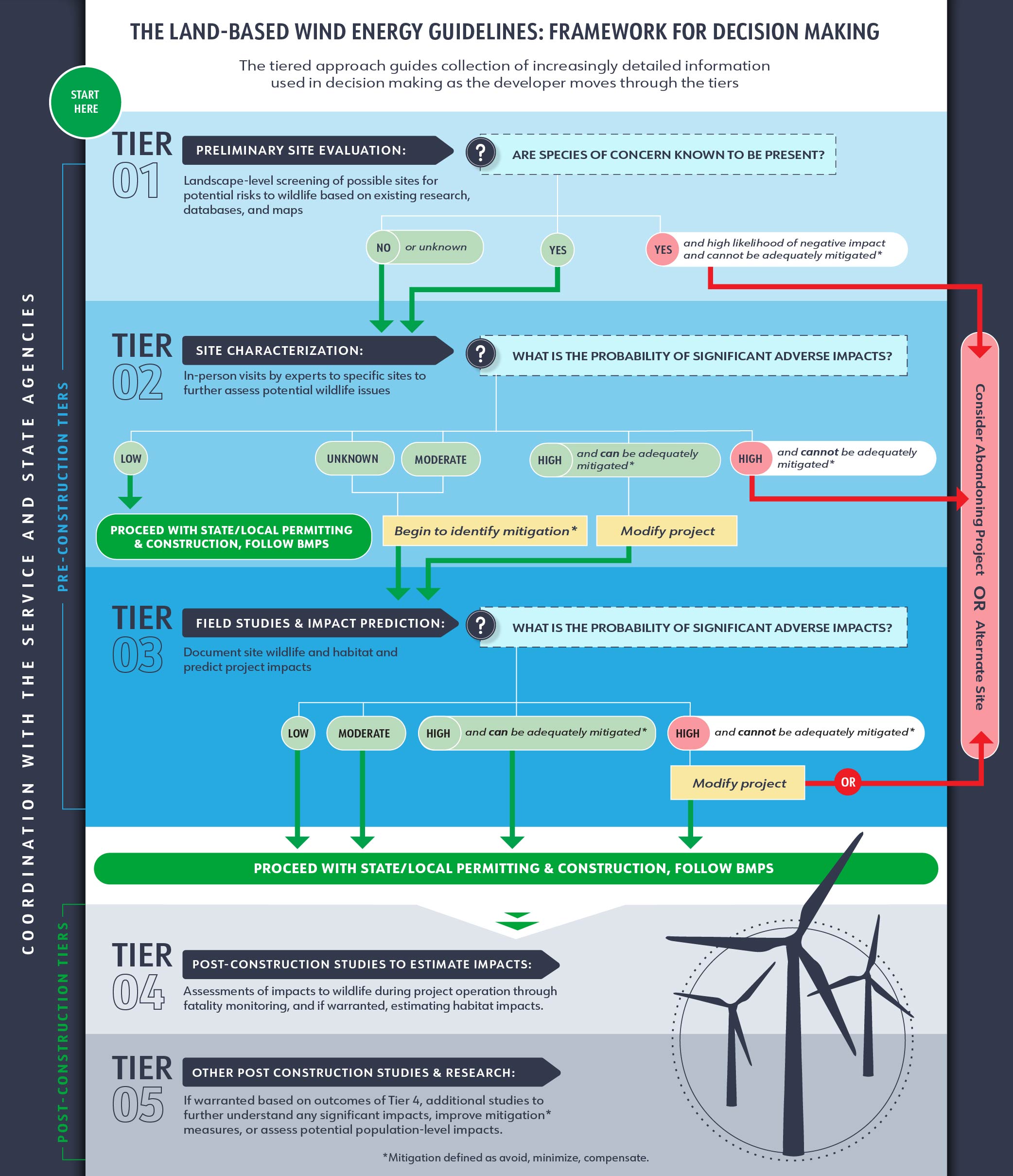01
Regulatory Context, Study Methods, and Development Guidelines
For nearly three decades, wind energy and wildlife stakeholders – industry, wildlife management agencies, conservation and science community – have collaborated to understand wind-wildlife interactions and create ways to develop wind energy while mitigating (meaning avoiding, minimizing, and compensating, for) impacts to wildlife. Wind project development and operation take place in the context of federal laws and regulations as well as state, regional, and local requirements designed to protect wildlife. Through the National Wind Coordinating Collaborative (NWCC), stakeholders developed guidelines for studying wind-wildlife interactions using standardized methods and metrics to make it possible to compare study results across projects. The U.S. Fish & Wildlife Service’s voluntary guidelines for land-based wind energy – developed as a result of consensus recommendations among federal and state agencies, industry, and conservation/science stakeholders – provide a framework for decision-making to assess risk and document potential impacts to wildlife and habitat from new wind energy development.
Mitigation Hierarchy: Avoid, Minimize, Compensate
Birds, bats, and other wildlife are present virtually everywhere, so it is not possible for wind energy facilities to completely avoid overlap with all species. Wildlife management agencies and wind energy developers follow a hierarchy to mitigate adverse impacts, trying first to avoid impacts to wildlife and habitats of greatest concern through project siting and design, and minimize during project development and operation those impacts that cannot be avoided. In some cases, project developers may take actions that compensate for impacts to wildlife or habitat that cannot be avoided or minimized.
Wind Energy Development in the Context of Federal Wildlife Statutes
Federal laws enacted to protect threatened and endangered species and conserve wildlife and other environmental resources play a role in shaping wind energy development. Key statutes include the Endangered Species Act (ESA), the Migratory Bird Treaty Act (MBTA), the Bald & Golden Eagle Protection Act (BGEPA), and the National Environmental Policy Act (NEPA). Protection under ESA, MBTA, and BGEPA involves prohibiting “take” – variously defined as activities that harass, harm, kill, capture, or otherwise disturb protected species. The U.S. Fish & Wildlife Service is responsible for administering and enforcing ESA, MBTA and BGEPA, developing regulations and guidelines, and working with wind energy developers to achieve compliance.
Role of Regional, State, and Local Agencies
Wildlife protection requirements, permitting requirements, and best management practices that apply to wind energy development and operation vary from state to state. Most states have their own lists of threatened and endangered species and species of concern in addition to species listed as threatened or endangered under the ESA, though the level of protections regulated by law varies by state. State Wildlife Action Plans serve as blueprints for conserving priority species of fish and wildlife. State wildlife management agencies (and other regional groups, non-governmental organizations, and federal agencies) maintain databases and other tools that can be useful for wildlife risk assessment. Wind energy developers can work with state and local agencies and other relevant local stakeholders in the wind project planning and development process to help identify and mitigate potential adverse impacts to wildlife and habitat.
A Common Toolkit for Evaluating Risk and Impacts
The NWCC, an independent multi-stakeholder forum funded by the U.S. Department of Energy to support sustainable wind power development in the U.S. from 1994-2021, published a guidance document to encourage greater consistency, rigor, and comparability of wind-wildlife studies at different projects. The Comprehensive Guide to Studying Wind Energy/Wildlife Interactions, developed in 1999 and revised in 2011, provides developers and agencies with a common “toolkit” for evaluating risk and measuring impacts. Standardized study methods and metrics improve project-specific analyses and enable stakeholders to learn more about wind-wildlife interactions and solutions through analysis of data from studies at multiple wind projects.
Voluntary Wind Energy Guidelines
The U.S. Fish & Wildlife Service’s voluntary Land-Based Wind Energy Guidelines offer wind companies a risk-based decision framework for evaluating and addressing the likelihood of adverse wildlife impacts resulting from wind energy development and operation. Issued in 2012, the Guidelines mirror the development process, incorporating study questions and methods that inform successive decisions to abandon or proceed with project development, or to collect additional information as needed. In coordination with federal and state agencies and other stakeholders, developers can follow the tiered approach to evaluate whether a site merits more detailed consideration, identify species of concern present at a site, predict risk and estimate impacts to these species, and determine available options to avoid, minimize, and offset wildlife impacts.
CHAPTER 02
What Do We Know about Impacts & Risk Factors to Wildlife and Habitat?
